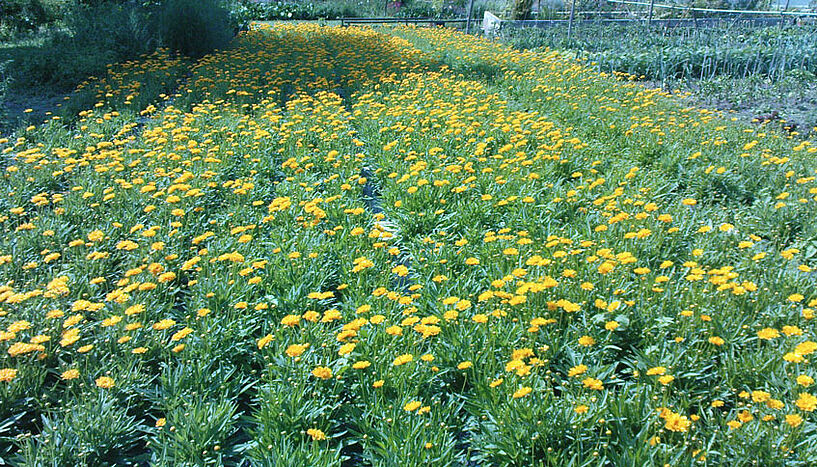Yellow as the sunrise
21. März 2016
Chemists from the University of Vienna around Annette Rompel have analysed the structure of the enzyme in the leaves of Coreopsis (Copyright: Annette Rompel).
Unraveling the structure and function of the enzyme aurone synthase
What is it that walnut leaves, mushrooms and Coreopsis have in common? An enzyme that is also responsible for the browning reaction in bananas or apples is present in all of them in large amounts. For the first time, chemists from the University of Vienna around Annette Rompel have analysed the structure of the enzyme in the leaves of Coreopsis.
Who doesn’t know the brown colour of a sliced apple or overripe fruit? Annette Rompel, Head of the Department of Biophysical Chemistry at the University of Vienna, knows this phenomenon very well. Since more than 20 years, she has studied the tyrosinase, an enzyme that does not only exist in plants but also makes the human skin become brown.
Unknown role of the enzyme
The “browning” is caused by a number of complex polyphenols. These are secondary plant metabolites that occur, e.g. as health-promoting colouring and flavouring components. Tyrosinase, in turn, is a metal-containing enzyme that catalyses the hydroxylation and oxidation of phenols. “And this is the reason for the discolouration”, explains the chemist.
In addition to tyrosinase, a second enzyme called catechol oxidase is capable of oxidising diphenols such as catechol. “Thus, both enzymes are responsible for the browning reaction”, says Rompel. The first author Christian Molitor stresses: “The actual physiological role of the enzymes in various cells as well as their natural substrates are still largely unknown.”
Mushrooms, walnut leaves and Coreopsis
The chemists have addressed this question. Having successfully characterised the enzymes in mushrooms and walnut leaves, the researchers now focus on another plant: Coreopsis – a popular garden plant whose flowers resemble those of sunflowers with their radiant yellow blossoms also found in the University’s greenhouse in Althanstrasse. “This is mainly due to the excellent work of the gardeners Thomas Joch and Andreas Schröfl”, says Rompel who praises the employees “with the green thumb”.
Where does the yellow colour come from?
“We have chosen Coreopsis for our research, because the “browning enzyme” is found in the petals in high concentrations”, says the chemist. The enzyme – in this case a catechol oxidase – is responsible for the conversion of certain flower pigments. “Since the petal dyes are called aurones, the enzyme received the name aurone synthase”, explains the chemist.
A new classification must be defined
Her team comprising Christian Molitor, Stephan Mauracher and Cornelia Kaintz managed to characterise this enzyme for the first time: In the paper recently published in PNAS, the researchers presented the first crystal structure of aurone synthase in both a latent and an active form. “In a third step, we had an inactive form (through sulfonation) isolated and crystallised”, says Molitor, adding: “With regard to the crystal structures of the latent, active and inactive form we achieved results that provide further insight into the complex mechanism of activation.”
With their work, the researchers from the University of Vienna also describe a new mechanism for the catalytic cycle of plant polyphenol oxidases, i.e. the “browning process” in plants. “Our results show that the general classification of tyrosinase and catechol oxidase must be reconsidered”, says first author Molitor.
Healthy application?
The research results could lead to applications in various disciplines, among others in biotechnological, pharmaceutical or agricultural processes. “Based on our results, you could – by controlling the enzymes –, for example, increase the content of bioactive substances in fruit and vegetables”, explains Rompel and smiles: “Fruit and vegetables would then become even healthier.”
The project results have been obtained within the scope of the FWF project “Structural studies of type 3 copper proteins” led by Prof. Annette Rompel, Head of the Department of Biophysical Chemistry at the University of Vienna. As part of their doctoral thesis, Christian Molitor, Stephan Mauracher and Cornelia Kaintz also worked on the project.
Publication in PNAS:
C. Molitor, S.G. Mauracher, A. Rompel: Aurone synthase is a catechol oxidase with hydroxylase activity and provides insights into the mechanism of plant polyphenol oxidases”, PNAS, 15 March, 2016
Wissenschaftlicher Kontakt
Univ.-Prof. Dr. Annette Rompel
Institut für Biophysikalische Chemie Fakultät für ChemieUniversität Wien
1090 - Wien, Althanstraße 14 (UZA II)
+43-1-4277-52502
annette.rompel@univie.ac.at
Rückfragehinweis
Mag. Alexandra Frey
Media Relations ManagerUniversität Wien
1010 - Wien, Universitätsring 1
+43-1-4277-17533
+43-664-8175675
alexandra.frey@univie.ac.at
Downloads:
Maedchenaugepflanzen_im_Augarten.JPG
Dateigröße: 825,22 KB
